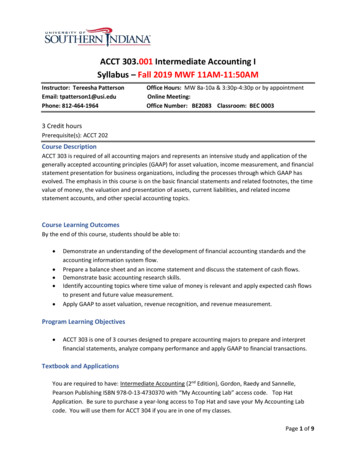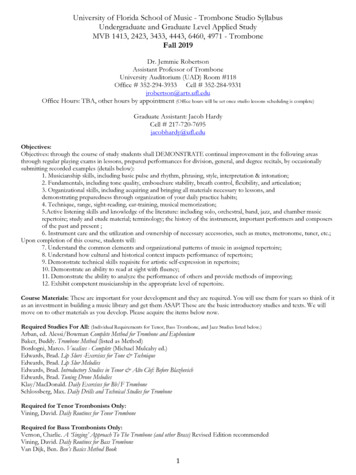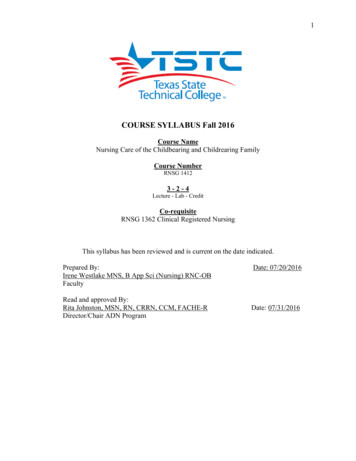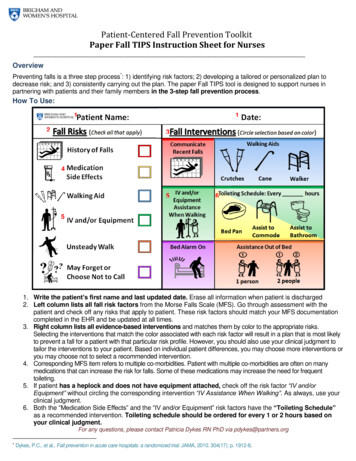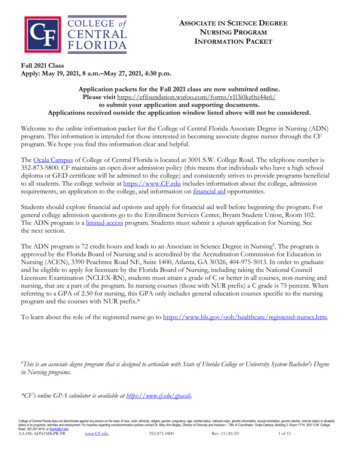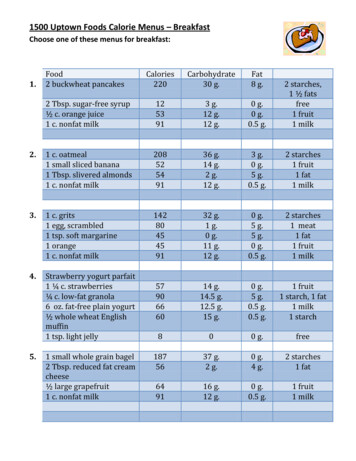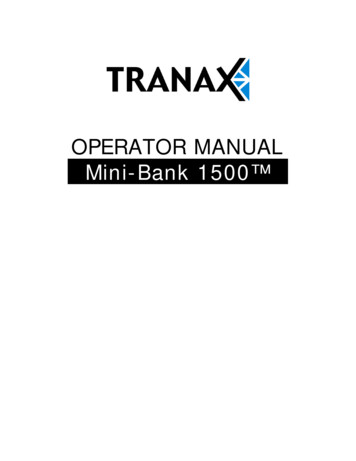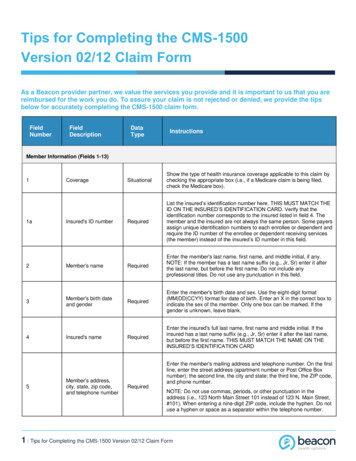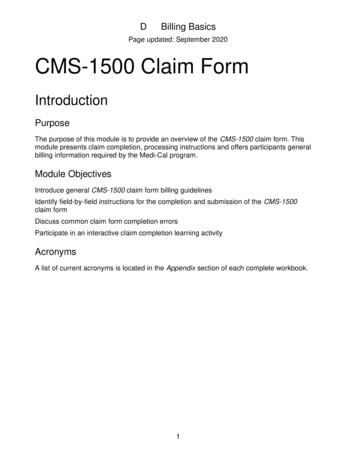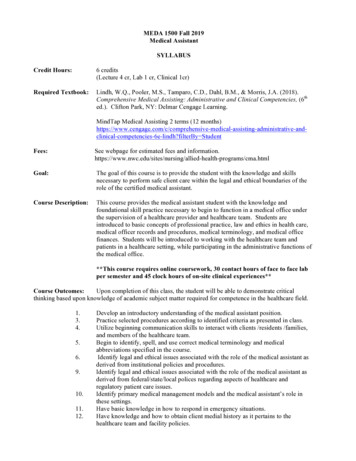
Transcription
MEDA 1500 Fall 2019Medical AssistantSYLLABUSCredit Hours:6 credits(Lecture 4 cr, Lab 1 cr, Clinical 1cr)Required Textbook:Lindh, W.Q., Pooler, M.S., Tamparo, C.D., Dahl, B.M., & Morris, J.A. (2018).Comprehensive Medical Assisting: Administrative and Clinical Competencies, (6thed.). Clifton Park, NY: Delmar Cengage Learning.MindTap Medical Assisting 2 terms (12 cies-6e-lindh?filterBy StudentFees:See webpage for estimated fees and ed-health-programs/cma.htmlGoal:The goal of this course is to provide the student with the knowledge and skillsnecessary to perform safe client care within the legal and ethical boundaries of therole of the certified medical assistant.Course Description:This course provides the medical assistant student with the knowledge andfoundational skill practice necessary to begin to function in a medical office underthe supervision of a healthcare provider and healthcare team. Students areintroduced to basic concepts of professional practice, law and ethics in health care,medical officer records and procedures, medical terminology, and medical officefinances. Students will be introduced to working with the healthcare team andpatients in a healthcare setting, while participating in the administrative functions ofthe medical office.**This course requires online coursework, 30 contact hours of face to face labper semester and 45 clock hours of on-site clinical experiences**Course Outcomes:Upon completion of this class, the student will be able to demonstrate criticalthinking based upon knowledge of academic subject matter required for competence in the healthcare field.1.3.4.5.6.9.10.11.12.Develop an introductory understanding of the medical assistant position.Practice selected procedures according to identified criteria as presented in class.Utilize beginning communication skills to interact with clients /residents /families,and members of the healthcare team.Begin to identify, spell, and use correct medical terminology and medicalabbreviations specified in the course.Identify legal and ethical issues associated with the role of the medical assistant asderived from institutional policies and procedures.Identify legal and ethical issues associated with the role of the medical assistant asderived from federal/state/local polices regarding aspects of healthcare andregulatory patient care issues.Identify primary medical management models and the medical assistant’s role inthese settings.Have basic knowledge in how to respond in emergency situations.Have knowledge and how to obtain client medial history as it pertains to thehealthcare team and facility policies.
13.14.Demonstrate beginning knowledge of medications and mediation administrationneeds.Identify the diverse types of human relations/interactions among client andhealthcare providers to include but not limited to: open communication, closedcommunication, verbal communication, non-verbal communication, writtencommunication and/or other forms of communication as deemed appropriate.Clinical and Laboratory Outcomes: Upon completion of this class, the student will incorporate thecognitive knowledge in performance of the psychomotor and affective domains in their practice as medicalassistants in providing patient care.1.2.3.4.Obtain vital signs and report abnormal findings.Select appropriate Personal Protective Equipment (PPE) and practice standardprecautions.Manage appointment schedule using established priorities.Perform front office tasks/duties as assigned including but not limited to:scheduling, rooming, payment, insurance billing, coding, and/or filing.Instructor:Jessica Heny, MSN, RNVisiting Instructor of NursingOffice: Cody CenterOffice hours: By AppointmentOffice phone: (307) 587-3376e-mail address: jessica.heny@nwc.eduPrerequisite:Must be 16 years or olderMETHODS OF INSTRUCTION:Learning labsClinical practiceDiscussionDemonstrations / Return DemonstrationsHomework AssignmentsReading AssignmentsEVALUATION OF ACHIEVEMENT OF LEARNING OUTCOMES:An overall grade of 74% or better must be obtained on quizzes, homework and the final exam to pass thecourse. After satisfactorily completing this course, the student will be eligible to take the medical assistantcertification exam and will receive instructions on the application process.You must have a 74% average or above in your coursework AND an “S” (satisfactory) and skill evaluationin lab and clinical evaluation with your preceptor, to successfully complete this course. The "S" (satisfactory)is derived from observation/feedback from your instructor or clinical preceptor. The % grade is derived fromthe scale as noted in this syllabus.Failure to complete the lab portion of this course will result in an automatic “F” failure unless otherarrangements are made with the instructor.Failure to achieve a satisfactory in the clinical portion of this course will result in an automatic “F” unlessother arrangements are made with the instructor.
WeekWeek 1August 21-27Concept OutlineIntroduction to MedicalAssisting and HealthProfessionsTopicsMedical Assisting ProfessionHealth Care settings and teamAssignmentChapters 12Week 2August 28-September 3Introduction to MedicalAssisting and HealthProfessionsTherapeutic CommunicationTherapeutic ApproachCoping SkillsChapters 35Week 3September 4-10Responsible MedicalPracticeLegal & Ethical ConsiderationsChapters 67Week 4September 11-17Responsible MedicalPracticeEmergency Procedures and First AidChapter 8Week 5September 18-24IntegratedAdministrativeProceduresCreating the facility environmentComputers in the care settingTelecommunicationsChapters 911Week 6September nt SchedulingMedical Records managementWritten CommunicationMedical DocumentsChapters12-15Week 7October 2-8Managing FacilityFinancesMedical Insurance & CodingChapters16-17Week 8October 9-15Managing FacilityFinancesDaily Financial PracticesBilling and CollectionsAccounting PracticesChapters18-20Week 9October 16-22Integrated ClinicalProceduresInfection Control and AsepsisChapter 21Week 10October 23-29Integrated ClinicalProceduresThe Patient History and DocumentationChapter 22Week 11October 30-November5Week 12November 6-12Integrated ClinicalProceduresVitals Signs and MeasurementsThe Physical ExaminationChapter 2324Assisting withSpecialty Examinationsand ProceduresObstetrics and GynecologyPediatricsChapters25-26Week 13November 13-19Assisting withSpecialty Examinationsand ProceduresMale Reproductive SystemGerontologyChapters27-28Week 14November 20-26THANKSGIVINGBREAKNO CLASS
Week 15November 27December 3REVIEW FOR FINALREVIEW FOR FINALWeek 16December 4-10FINALFINALLesson Objectives:Week 11. Identify and describe the three primary medical management models.2. Discuss the role of the medical assistant in the healthcare setting.3. Discuss the history of the medical assistant.4. Identify the nine attributes that are important for a professional medicalassistant to have.5. Recognize the agencies that provide regulation of health care provider.6. Define scope of practice for the medical assistant.7. Describe how attitudes toward illness are manifested today.Week 21. Identify the importance of communication.2. List the four basic elements of the communication cycle.3. Discuss the importance of active listening in therapeutic communication.4. Differentiate between stress and stressors.5. List the four stages of burnout.6. Describe possible patient perspectives when facing a life-threatening illness.7. List the four choices to be make when facing a life-threatening illness.8. Explain the differences between a living will, health care directive, and durablepower of attorney for health care.9. List the stages of grief and the acronym TEAR.Week 31. Verbalize understanding the different sources of law (i.e. statutory law,common law, criminal law, civil law)2. Explain the different types of administrative law (i.e. Title VII of the CivilRights Act, Federal Age Discrimination Act, Uniform Anatomical Gift Act,Regulation C of the Consumer Protection Act)3. Verbalize understanding of Occupational Safety and Health Act (OSHA).4. Define tort law.5. Explain informed consent the legal implications associated with informedconsent.6. Explain the Patient’s Bill of Rights.7. Verbalize understanding of Chain of Command in the healthcare setting.8. Explain the role of the medical assistant when abuse is suspected.9. Describe the function of the ethic committee.10. Verbalize understanding of when to involve the agency ethic committee.11. Explain HIPAA and its impact on today’s healthcare.Week 41. Learn to recognize, prepare for, and respond to emergencies in the healthcaresetting.2. Perform the primary assessment in an emergency situation per scope ofpractice.3. Understand the first responder role for identified injuries (i.e. use of atourniquet, pressure dressings, broken bone, muscle injury, poison, snake bite,burns, diabetic emergencies).4. Identify the chain of survival in an emergency situation.
Week 5Week 6Week 7Week 85. Complete Cardiopulmonary Resuscitation skill according to national standards(American Heart Association or American Red Cross).6. Explain the medical assistant’s role during a mass disaster / mass casualtyincident.1. Demonstrate important personality characteristics the receptionist shouldpossess.2. Determine cultural aspects to consider in reception area.3. Interpret the role of HIPAA in patient privacy and the facility environment.4. Analyze the importance of computer system documentation and how it isupgraded.5. Differentiate between electronic health records (EHR), electronic medicalrecords (EMR), and practice management (PM) system.6. Explain importance of system backup as well as ergonomics for setting up acomputer workstation.7. Identify guidelines for maintaining confidentiality for safeguarding personalhealth information (PHI) as well as electronic personal health information (ePHI)while keeping in mind HIPAA requirements.8. Discuss proper screening techniques with telephone screening and modelproper procedure for answering incoming calls, transferring calls, and placingoutgoing calls.9. Discuss telephone documentation and how calls from angry individuals shouldbe handled in a professional manner, and demonstrate steps to follow when thistype of call is received.1. Identify the different types of scheduling (i.e. wave booking, double booking,modified wave booking, stream/time-specific booking, open booking and clusteror categorization booking)2. Verbalize understanding of protocols for no-show, missed, cancelled, orfollow-up appointments.3. Verify information on an encounter form.4. Demonstrate knowledge of filing systems (i.e. electronic, alphabeticalprocedure, terminal digit procedures).5. Compose and key letters using appropriate components of a business letter.6. Proofread a letter for grammar, spelling, and content.7. Differentiate between chart notes, history and physical examination reports,radiology and imaging reports, operative reports, pathology reports,consultations, discharge summaries, autopsy reports, and correspondence.1.List at least five examples of medical insurance coverage and discuss theirdifferences.2. Obtain managed care referrals, precertification, and preauthorization, includingdocumentation.3. Define terminology necessary to understand and code medical insurance claimforms.1. Demonstrate ability to collect and record payments and understanding ofpatient’s insurance responsibilities.2. Identify circumstances that require adjustment of fees and post accordingly.3. Develop knowledge of various credit arrangements for patient fees.4. Describe the encounter form.5. Analyze importance of billing and collections to the clinic, and describeadvantages of billing at least the co-payment and co-insurance at time of service.
Week 9Week 10Week 11Week 126. Explain purpose and range of accounting function in the clinic and describefour different types of bookkeeping and accounting systems.1. Discuss the process of infection and the chain of infection.2. Identify the body’s defense mechanisms for fighting infection and disease.3. Discuss the role of the medical assistant in reporting infectious diseaseprocesses.4. Identify the differences between handwashing, sanitization, and disinfection.5. Describe the necessary precautions needed for: Standard precautions(Universal precautions), airborne precautions, contact precautions, and dropletprecautions.6. Identify the components of bloodborne pathogen standards.7. Define surgical asepsis and differentiate between surgical asepsis and medicalasepsis.8. List eight basic rules to follow to protect sterile areas.9. Explain the different methods of surgical instrument sterilization.10. Define anesthesia and explain the advantages and disadvantages ofepinephrine as an additive to injectable anesthetics.11. List five preoperative concerns to be addressed in patient preparation andeducation.12. List five postoperative concerns to be addressed with the patient and thecaregiver.13. Explain with is meant by alternative surgical methods.1. Describe the purpose of the medical history.2. Identify the different types of medical records (i.e. physical, mental, electronic)3. Correctly obtain and document patient demographics and health insuranceinformation.4. Demonstrate the correct process for the patient intake interview.5. Demonstrate effective communication using SOAP(ER), SBAR, and PIEcharting.1. Describe the importance in obtaining patient vital signs.2. Identify the different ways to obtain body temperature.3. Demonstrate the ability to obtain and report correct pulse, respiration,temperature, blood pressure, and oxygen saturation.4. Identify the fifteen pulse sites on the human body.5. Identify the normal range for pulse, respiration, and blood pressure for thepatient throughout the lifespan.6. Describe the methods used in physical examination.7. Name and describe seven positions used for physical examination.8. Discuss the purpose of draping and demonstrate appropriate draping for eachposition.9. Describe the sequence followed during a physical examination.10. Identify selected instruments used during a physical examination.1. Define the importance of prenatal care and discuss what examinations will beperformed as part of the initial visit.2. List twelve conditions or diseases that can cause a pregnant woman and herfetus to be at greater risk for problems during the pregnancy.3. Calculate expected date of confinement (EDC) or expected date of delivery(EDD) using Nagele’s Rule and using the gestation wheel.4. Describe the medical assistant’s role during an obstetric ultrasonography andamniocentesis.
Week 145. Identify the laboratory tests and procedures that can help diagnose the diseasesand disorders that can affect the female patient.6. Describe the medical assistant’s role during a gynecological examination,vasectomy procedure, or tubal ligation procedure.7. Identify patient teaching methods for gynecological procedure, sperm countprocedure, and contraceptive methods.8. Describe various theories of human development.9. Explain the role of the medical assistant when evaluating common disordersand diseases in the pediatric patient (i.e. otitis media, pediculosis, asthma,Pertussis, RSV, ADHD).10. Describe the alterations needed when performing a pediatric assessment.11. Identify the landmarks needed when administering a subcutaneous injectionand intramuscular injection on a pediatric patient.12. Demonstrate use of pediatric growth charts (male and female).1. Identify signs and symptoms of the various disorders and diseases of the malereproductive system.2. Explain erectile dysfunction, its causes, and its treatments.3. Explain how to educate a male client on testicular self-examination and benignhyperplasia of the prostate (BPH).4. Identify expected physiologic changes that occur as part of the aging process.5. Describe prevention techniques for complications arising from age-relateddisorders.6. Explain the importance of communication with older adults.7. Identify three techniques or strategies to communicate with visually andhearing-impaired older adults.8. Describe teaching strategies for healthy and successful aging.THANKSGIVING BREAKWeek 15REVIEW FOR FINALWeek 16FINALWeek 13METHODS OF EVALUATION:HOME WORKWEEKLY EXAMFINAL EXAMINATIONLAB factorySatisfactory/UnsatisfactoryGRADING SCALE:A 95-100%A 90-94%B 87-89%B 84-86%B 80-83%C 77-79%C 74-76%4.0 points3.7 points3.3 points3.0 points2.7 points2.3 points2.0 points
CD DDFSUW 70-73% 67-69% 64-66% 60-63% below 60% Satisfactory Unsatisfactory Withdrawn1.7 points1.3 points1.0 points0.7 points0.0 points0.0 points0.0 points0.0 pointsThere will be no extra credit opportunities during this course.LATE ASSIGNMENTS:Late assignments or Missed Assignments will not be accepted unless prior arrangements have been made.EXAMINATION POLICY:Students are expected to take all exams on the day(s) they are scheduled. You may not make up a missedexam unless you’ve made prior arrangements with your instructor. Any exam without prior instructorapproval will be given a grade of “0”.LAB REQUIREMENTS:As part of this course, medical assistant skill demonstrations will be provided and the students will have anopportunity to practice these skills in a laboratory setting. Skill performance evaluations will be conductedon each student to determine skill proficiency and are graded as Satisfactory/Unsatisfactory. All Skills mustbe performed satisfactorily before the student will be allowed to perform skills in the clinical setting.Completion of this requirement is mandatory for progression in this course.LAB SUPPLIES NEEDED:Casual attire is acceptable within the laboratory setting. (Please dress appropriately; closed toe shoes are amust). You will also need a watch with a second hand. Supplies kits will be given and if additional suppliesare needed during this course, they will be distributed as needed within the laboratory setting.LAB SCHEDULE:Mondays, 4:30-6:30pmLAB ATTENDANCE:Due to the interactive learning methods and limited opportunity to obtain lab / skill information, studentattendance is mandatory for this course. This course requires active participation online and in lab.Therefore, students are expected to attend each assigned lab and will be excused only under the mostemergent circumstances. Students with an unavoidable absence must e-mail or leave a voice mail for theinstructor as soon as possible regarding their absence. It is not guaranteed that lab skill make-up days maybe scheduled.PRE-CLINICAL REQUIREMENTS:Background checks, drug screening, and immunization requirements must be met before students can attendclinical. Students who are unable to satisfactorily meet the expectations of the background check and drugscreening, and/or fail to complete the required immunizations will not be allowed to attend clinical experiences.Students who fail to attend the required clinical experiences are unable to meet the clinical expectations requiredin this course and will be asked to withdraw from the course.CLINICAL EXPERIENCES:Preceptors are individuals currently working in a medical office that can provide expertise in the medical clinicenvironment. Preceptors work alongside the student to expose the student to the various duties andresponsibilities of the medical assistant. Preceptors serve as a role model to the student and facilitate anenvironment where students can learn what it means to be a medical assistant in a medical setting. Preceptors are
located throughout the NWC service area and students will be assigned to a variety of locations to give studentsthe opportunity to engage in the function of large and small medical settings. Preceptors provide
2. Discuss the role of the medical assistant in the healthcare setting. 3. Discuss the history of the medical assistant. 4. Identify the nine attributes that are important for a professional medical assistant to have. 5. Recognize the agencies that provide regulation of health care provider.
